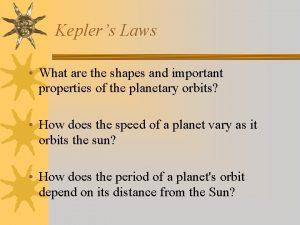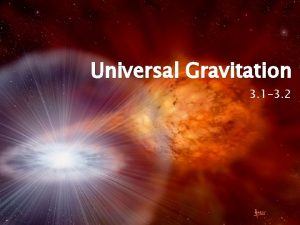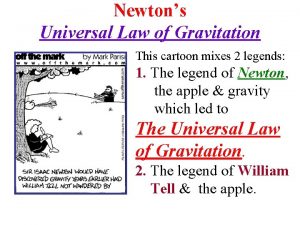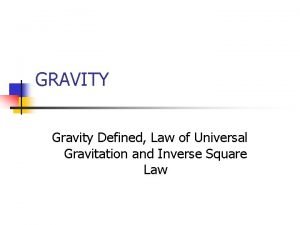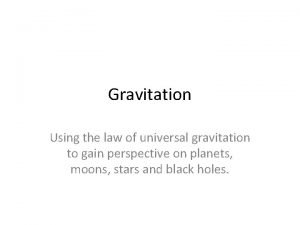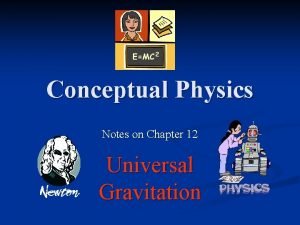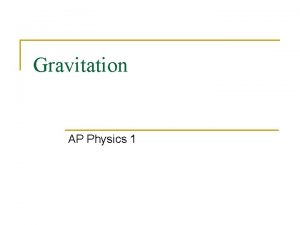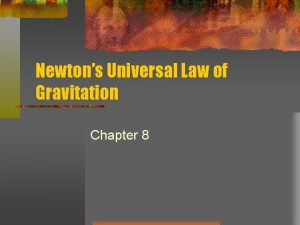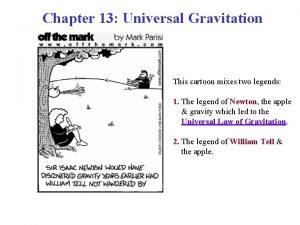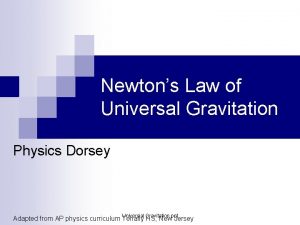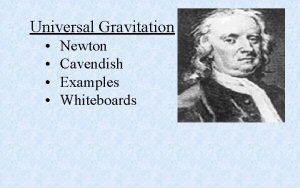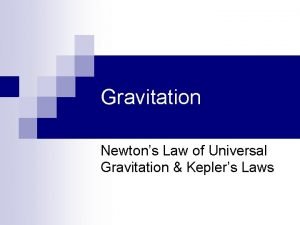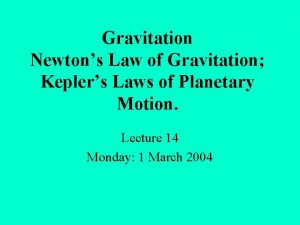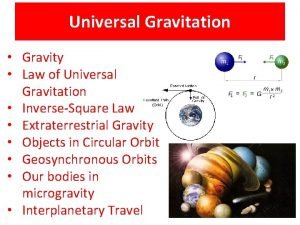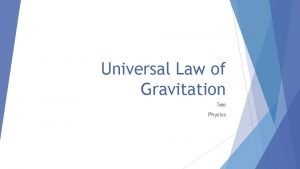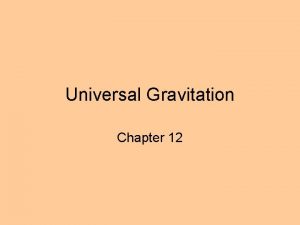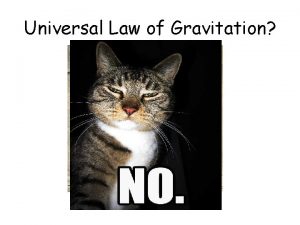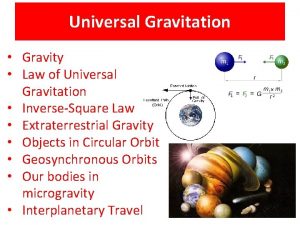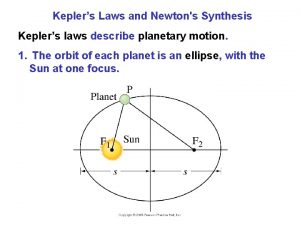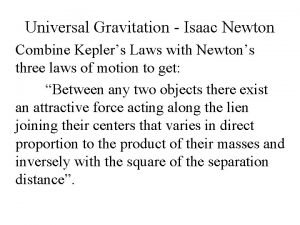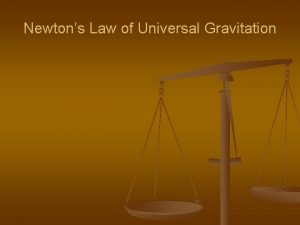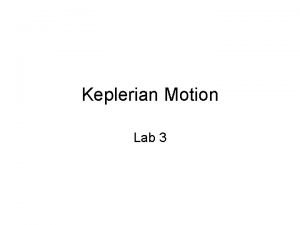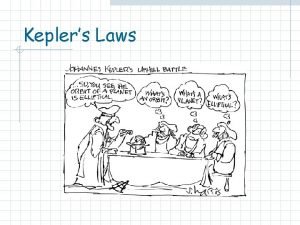Keplers Laws and Universal Gravitation Keplers Laws of














- Slides: 14

Kepler’s Laws and Universal Gravitation

Kepler’s Laws of Planetary Motion

Kepler’s 1 st Law Planetary Motion The path of the planets around the sun are ellipses with the sun at one of the focus points Consequence: The planets traveling in their orbits are sometimes closer to the sun and other times further away Note: The orbits are only slightly elliptical. They are close to circular. 1.

Kepler’s 2 nd Law of Planetary Motion 2. The planets sweep out equal areas in equal time intervals no matter how close or far away a planet is from the sun Consequence: Planets speed up as they move closer to the sun and slow down as they move further away

Kepler’s 3 rd Law Planetary Motion 3. The ratio of the squares of the Periods of any two planets going around the sun is equal to the ratio of the cubes of their Average Distances away from the sun. Consequence: Planets that are farther away from the sun have a longer Period of Revolution

Equation for Kepler’s 3 rd Law can be written in an equation form. 2 ) (Ta 2 (Tb) Kepler’s = 3 ) (Ra 3 (Rb) 3 rd law applies to any two objects going around a third central object! (2 planets around the sun or 2 moons around a planet)

Astronomical Units (A. U. ) Measurement of distance between two different planets Ex) average distance between the Earth and the Sun is d. E-S = 1. 5 x 1011 m 1 A. U. = 1. 5 x 1011 m d. E-S = 1 A. U.

Universal Gravitation aka. A Gravity force of attraction between any two masses and that each mass pulls on the other with an equal and opposite force

Universal Gravitation The Force of Gravity is directly proportional to the mass of each object Fam The Force of Gravity is inversely proportional to the square of the distance between the center of the masses F a 1/d 2 (Inverse Square Law)

Universal Gravitation Equation Newton used his Law of Gravity (Universal Gravitation) to make the following equation: F g = G m 1 m 2 d 2 Where “G” is the Universal Gravitational Constant! G = 6. 67 x 10 -11 Nm 2/kg 2

Universal Gravitation Equation Note: In using the Universal Gravitation Equation, One mass(m 1) doubles - Fg is doubled Both masses(m 1, m 2) double– Fg is quadrupled (multiplied by 4) Distance(d) doubles – Fg is divided by 4 (22 = 4) Note: d has to be measured from center to center! (Not center to SURFACE!)

Universal Gravitation and Acceleration Due to Gravity The acceleration due to gravity (g) changes if you go to another planet or moon or as you move away from the surface of Earth g = 9. 8 m/s 2 at the surface of the Earth g will be greater on a larger planet (Jupiter g. J = 25 m/s 2) g will be smaller on a smaller planet (Mercury g. M = 3. 78 m/s 2)

Satellites The Moon is a satellite of the Earth! The Earth is a satellite of the Sun! Jupiter’s Moons are satellites of Jupiter! We put up man-made satellites around the Earth and other planets! Most of the man-made satellites going around the Earth are Geosynchronous (have a period, T = 24 hours)

Gravitational Field Gravity is not a contact force. Therefore, masses produce a Gravitational Field! g measures the gravitational field strength acting on an object g = Fg/m
 Universal gravitation law
Universal gravitation law Kepler law
Kepler law Kepler's 3 laws of motion
Kepler's 3 laws of motion Explain newton’s universal law of attraction/gravitation.
Explain newton’s universal law of attraction/gravitation. Vector form of gravitational force
Vector form of gravitational force Gravity
Gravity The law of universal gravitation states that
The law of universal gravitation states that Universal gravitation law
Universal gravitation law Conceptual physics chapter 13 universal gravitation
Conceptual physics chapter 13 universal gravitation Universal law of gravitation calculator
Universal law of gravitation calculator Newton's universal law of gravitation ap physics 1
Newton's universal law of gravitation ap physics 1 Newton's universal law of gravitation simplified
Newton's universal law of gravitation simplified Cartoon law of universal gravitation
Cartoon law of universal gravitation Law of universal gravitation ppt
Law of universal gravitation ppt Law of universal gravitation kid definition
Law of universal gravitation kid definition

